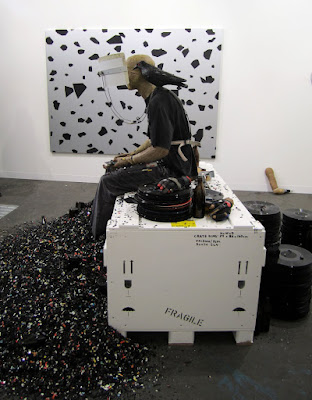Around Town: Guggengeim and Design


I got up in the morning with the idea to conquer MoMA, The Guggenheim, Chelsea, and then meet up for a studio visit. Being a mere mortal I made it to the Gift Shop at MoMA where I fell into a sublime trajectory that is shopping at a store that is full of really interesting, well designed stuff. Didn't get into the museum. Oops. Instead I decided to check out the Guggenheim since I'd never been and it's on the right side of the park for my next endeavor. The Guggenheim is interesting if for nothing other than the building itself. The last construction of Frank Lloyd Wright and the site of one of Matthew Barney's Creamaster films, it is something to be reckoned with. Unless over half of it is closed for an installation of Lee Ufan's work. Since I'm interested in how things work I spent some time leering dangerously into the closed areas, stepping an extra toe past the rope to peer into the process of hanging a show. There was quite a crew working on it and large, wrapped wall pieces on carts everywhere. I got shoo'd back into the Thannhauser Collection.
Here's how Solomon Guggenheim acquired this lovely collection of Modern greats. Justin Thannhauser (1892-1976) was the son of an art dealer who founded an art gallery in Munich in 1909. His father, Heinrich Thannhauser open several more galleries in Europe before WWII that closed with the war. When Heinrich died in 1935, his son Justin moved to New York with the work and became a private art dealer. In 1963 he donated a significant part of his collection to the Guggenheim. The collection consists of some easily identifiable, smaller works of the most famous Modern artists, from Impressionists to the Avante-Garde.

The piece that I think is most significant is the piece by Picasso from his Blue Period of a woman ironing. It is a classic that is reproduced frequently as an example of his expression of the lives of the working poor. There were also a couple pieces by the untrained artist Henri Rousseau. It's interesting that a person could make art without training, never get positive recognition for it's awkward, disproportionate nature and die a pauper. Only posthumously to be awarded status because they hung in the circles of other famous artists. It gives hope to many people living in the post-modern world. However, that would never happen today. If you die a poor artist your family and friends will simply miss you and probably sell your work at a garage sale or keep it in their living rooms as a conversation piece.


 (example of other work)
(example of other work)




Comments
Post a Comment